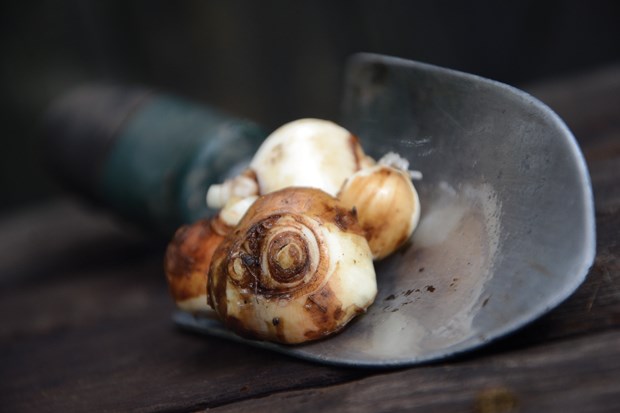Fall is an optimum season to plant almost any plant in the garden, but October is really bulb-planting season.
Beyond daffodils and tulips, there are a wealth of other bulbs to plant, with options for any garden. From giant onions (Allium species) that rise a metre (three feet) above the soil, to the tiny 10 centimetre-(four inch-) tall winter aconite (Eranthis hyemalis) that blooms yellow in late-January.
Taller growing bulbs like tulips and daffodils are suitable for planting amongst trees, shrubs and perennials. Medium-height bulbs like species tulips, which are fabulous, are best planted among low growing or rock garden plants to ensure they do not get overrun by larger plants. Low-growing bulbs like Cyclamen, Muscari and Puschkinia species are best planted in dedicated foreground space where they can flourish without being overgrown by larger plants. And don't forget to naturalize some crocus or daffodils into the lawn.
I consistently read the same bad advice on the web for planting bulbs. Such as, adding fertilizer to the bulb planting hole - wrong. It is unsustainable and unhealthy to force excessive growth on any plant let alone a flowering bulb that has no roots to uptake the fertilizer. The fertilizer is leached into the ocean and you waste your money while damaging the environment.
The universal recommendation of adding bone meal to every bulb planting hole is also wrong. Do not add bone meal unless a soil test indicated a need to boost the phosphorus in the soil. Most soils have plenty of phosphorus and compost, well-rotted manure, leaf mould and even some soil amenders will contain ample amounts of phosphorus. Too much bone meal can cause nutrient antagonisms resulting in the locking up of other nutrients. If you absolutely must add bone meal because you know your soil is low in phosphorus, then add a pinch - less than a level teaspoon - to each group of 10 bulbs. A little goes a long way and more is not better.
If you have added bone meal, compost or manure to your soil in the last seven years then you do not need more.
Another incorrect directive for planting bulbs states that people should add composted manure to the bulb's planting hole. Please do not. Adding manure directly into the planting hole can lead to bulb rot, especially if the manure is not thoroughly composted.
It's important to note that most bulbous plants naturally grow in lean soils, rocky soils, out in meadows or on the edges of forests. Flowering bulbs do not naturally grow in excessively fertile soil. Drainage is important since bulb rot is predominately caused by poor drainage.
For all bulbs, regardless of whether they are spring or summer flowering, here is how to prepare the soil for planting. Dig over the soil where you want to plant your bulbs and incorporate some compost, leaf mould or soil amender. Only use manure that's well decomposed. Do not use mushroom manure, it's too alkaline.
Evenly mix the soil amendment into the soil, not just in the planting hole. Do not add fertilizer as there are no roots to take it up. Always dig deep to ensure there is good drainage below the bulbs to avoid bulb rot.
Alternately, if you have reasonable soil that drains, do nothing but plant your bulbs "au natural." And regardless of rainfall, water your bulbs after planting to settle the soil and then cover the soil with mulch.
When it comes to buying bulbs on the retail market my advice is this: Try to buy bulbs grown, or at a minimum sold by B.C.-based businesses, which supports our local bulb growers, keeping jobs and money in our province. In Langley there is Botanus Inc. (botanus. com), which sells directly to the public. Also in Langley is the Van Noort Bulb Co. (vannoortbulb. com), which is primarily a wholesaler of bulbs but they can direct you to a garden centre that sells their bulbs.
There are other suppliers like Pan American Nursery Products in Surrey, which is a threegeneration family business (panamnursery.com) but they are wholesale only.
Then there is the community of Bradner out in Abbotsford where there are several bulb growers. You'll have to do some homework to find out whom. Local garden centres are great places to find some cool and unusual bulbs, provided you ask if they are supporting B.C. nursery and bulb growers.
When it comes to which bulb to choose, try not to fixate on design rules or additives. Seek instead to find a place in the garden for harmonic growth of flowering bulbs. Ultimately, it does not matter what I might recommend. You have to choose a bulb species and colour that moves you emotionally and suits your personality.
Todd Major is a journeyman horticulturist, garden designer and builder, teacher and organic advocate. [email protected]



